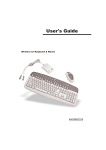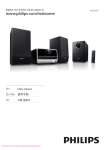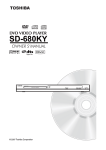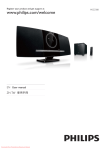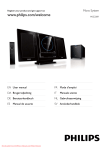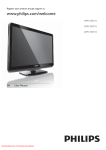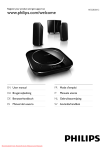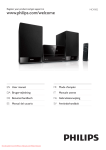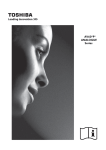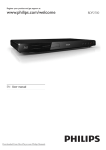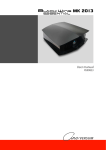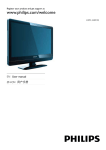Download Philips MCD802/98 User's Manual
Transcript
Register your product and get support at
DVD Micro Theater
www.philips.com/welcome
MCD802/98
EN
User manual
TH
คู่มือผู้ใช้
=+7: Ԛ͂ʹ˫
KO
␚⫔#⒢ᴮ⒚
1 Important
Safety
Notice
2 Your Micro Theater
Introduction
What’s in the box
Overview of the main unit
Overview of the remote control
3 Connect
Connect control cable
Connect speakers
Connect TV (video)
Connect an external audio system
(optional)
Connect FM antenna
Connect power
4 Get started
Install remote control batteries
Set clock
Turn on
Select the correct source on TV
Select the correct TV system
Change system menu language
Turn on Progressive Scan
5 Play
Play disc
Play from USB
Play DivX video
View pictures
Play control
Play options
6 Adjust sound
Adjust volume
Boost sound power
Mute sound
Select a preset sound effect
Enhance bass
4
4
6
8
8
8
9
10
13
13
13
13
15
15
16
17
17
17
17
17
18
18
18
19
19
19
19
20
20
21
7 Adjust settings
24
24
24
25
26
General setup
Audio setup
Video setup
Preferences
8 Listen to the radio
29
29
29
29
29
30
30
30
First time tuning
Tune to a radio station
Reinstall radio stations
Program radio stations manually
Select a preset radio station
Delete a preset radio station
Change tuning grid
9 Use more of your Micro Theater
Set the alarm timer
Set the sleep timer
Karaoke
Play from an external device
Create MP3 files
Record to a digital recorder
Listen through headphone
10 Product information
31
31
31
31
32
32
33
33
34
34
35
35
36
Specifications
Supported disc formats
USB playability information
Maintenance
11 Troubleshooting
37
12 Glossary
39
23
23
23
23
23
23
EN
3
E n g lish
Contents
1 Important
Safety
Important Safety Instructions
a Read these instructions.
b Keep these instructions.
c Heed all warnings.
d Follow all instructions.
e Do not use this apparatus near water.
f Clean only with dry cloth.
g Do not block any ventilation openings.
Install in accordance with the
manufacturer’s instructions.
h Do not install near any heat sources
such as radiators, heat registers, stoves,
or other apparatus (including amplifiers)
that produce heat.
i Protect the power cord from being
walked on or pinched, particularly at
plugs, convenience receptacles, and
the point where they exit from the
apparatus.
j Only use attachments/accessories
specified by the manufacturer.
k Use only with the cart, stand,
tripod, bracket, or table specified by
the manufacturer or sold with the
apparatus. When a cart is used, use
caution when moving the cart/apparatus
combination to avoid injury from tipover.
4
EN
l Unplug this apparatus during lightning
storms or when unused for long periods
of time.
m Refer all servicing to qualified service
personnel. Servicing is required when
the apparatus has been damaged in any
way, such as power-supply cord or plug
is damaged, liquid has been spilled or
objects have fallen into the apparatus,
the apparatus has been exposed to rain
or moisture, does not operate normally,
or has been dropped.
n Battery usage CAUTION – To prevent
battery leakage which may result in
bodily injury, property damage, or
damage to the unit:
• Install all batteries correctly, + and
- as marked on the unit.
• Do not mix batteries (old and new
or carbon and alkaline, etc.).
• Remove batteries when the unit is
not used for a long time.
o Apparatus shall not be exposed to
dripping or splashing.
p Do not place any sources of danger on
the apparatus (e.g. liquid filled objects,
lighted candles).
q This product may contain lead and
mercury. Disposal of these materials
may be regulated due to environmental
considerations. For disposal or recycling
information, please contact your local
authorities or the Electronic Industries
Alliance: www.eiae.org.
Know these safety symbols
This ‘bolt of lightning’ indicates uninsulated
material within your unit may cause an
electrical shock. For the safety of everyone
in your household, please do not remove
product covering.
The ‘exclamation point’ calls attention to
features for which you should read the
enclosed literature closely to prevent
operating and maintenance problems.
WARNING: To reduce the risk of fire or
electric shock, this apparatus should not be
exposed to rain or moisture and objects filled
with liquids, such as vases, should not be
placed on this apparatus.
CAUTION: To prevent electric shock, match
wide blade of plug to wide slot, fully insert.
• Where the MAINS plug or an appliance
coupler is used as the disconnect device,
the disconnect device shall remain readily
operable.
Risk of overheating! Never install this
apparatus in a confined space. Always leave
a space of at least four inches around this
apparatus for ventilation. Ensure curtains or
other objects never cover the ventilation slots
on this apparatus.
Warning
• Never remove the casing of this apparatus.
• Never lubricate any part of this apparatus.
• Never place this apparatus on other electrical
equipment.
• Keep this apparatus away from direct sunlight,
naked flames or heat.
• Never look into the laser beam inside this
apparatus.
• Ensure that you always have easy access to the
power cord, plug or adaptor to disconnect this
apparatus from the power.
Listen at a moderate volume.
• Using headphones at a high volume can
impair your hearing. This product can
produce sounds in decibel ranges that
may cause hearing loss for a normal
person, even for exposure less than a
minute. The higher decibel ranges are
offered for those that may have already
experienced some hearing loss.
• Sound can be deceiving. Over time your
hearing ‘comfort level’ adapts to higher
volumes of sound. So after prolonged
listening, what sounds ‘normal’ can
actually be loud and harmful to your
hearing. To guard against this, set your
volume to a safe level before your hearing
adapts and leave it there.
To establish a safe volume level:
• Set your volume control at a low setting.
• Slowly increase the sound until you can
hear it comfortably and clearly, without
distortion.
Listen for reasonable periods of time:
• Prolonged exposure to sound, even
at normally ‘safe’ levels, can also cause
hearing loss.
• Be sure to use your equipment
reasonably and take appropriate breaks.
Be sure to observe the following guidelines
when using your headphones.
• Listen at reasonable volumes for
reasonable periods of time.
• Be careful not to adjust the volume as
your hearing adapts.
• Do not turn up the volume so high that
you can’t hear what’s around you.
• You should use caution or temporarily
discontinue use in potentially hazardous
situations. Do not use headphones while
operating a motorized vehicle, cycling,
skateboarding, etc.; it may create a traffic
hazard and is illegal in many areas.
EN
5
E n g lish
Hearing safety
Notice
Any changes or modifications made to this
device that are not expressly approved by
Philips Consumer Lifestyle may void the user’s
authority to operate the equipment.
Recycling
Your product is designed and manufactured
with high quality materials and components,
which can be recycled and reused.
When you see the crossed-out wheel bin
symbol attached to a product, it means the
product is covered by the European Directive
2002/96/EC:
Never dispose of your product with other
household waste. Please inform yourself about
the local rules on the separate collection of
electrical and electronic products. The correct
disposal of your old product helps prevent
potentially negative consequences on the
environment and human health.
Your product contains batteries covered by
the European Directive 2006/66/EC, which
cannot be disposed of with normal household
waste.
When you see the crossed-out wheel bin
symbol with the chemical symbol ‘Pb’, it
means that the batteries comply with the
requirement set by the directive for lead:
6
EN
Pb
Please inform yourself about the local rules on
separate collection of batteries. The correct
disposal of batteries helps prevent potentially
negative consequences on the environment
and human health.
Environmental information
All unnecessary packaging has been omitted.
We have tried to make the packaging easy to
separate into three materials: cardboard (box),
polystyrene foam (buffer) and polyethylene
(bags, protective foam sheet.)
Your system consists of materials which can
be recycled and reused if disassembled by
a specialized company. Please observe the
local regulations regarding the disposal of
packaging materials, exhausted batteries and
old equipment.
This product incorporates copyright
protection technology that is protected
by method claims of certain U.S. patents
and other intellectual property rights
owned by Macrovision Corporation and
other rights owners. Use of this copyright
protection technology must be authorized
by Macrovision Corporation, and is intended
for home and other limited viewing uses only
unless otherwise authorized by Macrovision
Corporation. Reverse engineering or
disassembly is prohibited.
Consumers should note that not all high
definition television sets are fully compatible
with this product and may cause artifacts to
be displayed in the picture. In case of 525
or 625 progressive scan picture problems,
Manufactured under license from Dolby
Laboratories.
“Dolby” and the double-D symbol are
trademarks of Dolby Laboratories.
E n g lish
it is recommended that the user switch the
connection to the ‘standard definition’ output.
If there are questions regarding our TV set
compatibility with this model 525p and 625p
DVD player, please contact our customer
service center.
Windows Media and the Windows logo are
trademarks, or registered trademarks of
Microsoft Corporation in the United States
and/or other countries.
ENERGY STAR and the ENERGY STAR mark
are registered U.S. marks.
This apparatus includes this label:
HDMI, and HDMI logo and High-Definition
Multimedia Interface are trademarks or
registered trademarks of HDMI licensing LLC.
DivX, DivX Ultra Certified, and associated
logos are trademarks of DivX, Inc. and are
used under license.
Official DivX® Ultra Certified product.
Plays all versions of DivX® video (including
DivX® 6) with enhanced playback of DivX®
media files and the DivX® Media Format.
Plays DivX® video with menus, subtitles and
audio tracks.
Manufactured under license under U.S. Patent
#’s: 5,451,942; 5,956,674; 5,974,380; 5,978,762;
6,487,535 & other U.S. and worldwide patents
issued & pending.
DTS and DTS Digital Surround are registered
trademarks and the DTS logos and Symbol are
trademarks of DTS, Inc.© 1996-2007 DTS, Inc.
All Rights Reserved.
EN
7
2 Your Micro
Theater
You can play DVD discs with the following
region codes:
DVD region code Countries
Asia Pacific, Taiwan, Korea
Congratulations on your purchase, and
welcome to Philips! To fully benefit from the
support that Philips offers, register your product
at www.Philips.com/welcome.
Introduction
With this unit, you can:
• watch video from DVD/VCD/SVCD or
USB devices
• enjoy audio from discs or USB devices
• view photos from discs or USB devices
• tune to radio stations
• enjoy karaoke
You can enrich sound output with these
sound effects:
• Digital Sound Control (DSC)
• Dynamic Bass Boost (DBB)
The unit supports the these media/disc
formats:
8
EN
Australia, New Zealand
What’s in the box
Check and identify the contents of your
package:
• Main unit
• Loudspeaker boxes x 2
• Composite video cable (yellow)
• Control cable
• Power cord
• Remote control with batteries
• FM wire antenna
• FM T-Type antenna
• User manual
• Quick start guide
E n g lish
Overview of the main unit
a
b
j
c
k
d
l
m
e
n
f
o
g
p
q
h
r
i
s
a MAX
• Turn on or off instant power boost
for sound.
g
b DBB
• Turns on or off dynamic bass
enhancement.
h SOURCE
• Select a source: DISC, USB, FM,
AUX or MP3 LINK.
c DSC
• Select a preset sound setting.
i Display panel
• Show current status.
d USB REC
• Access the menu to create MP3.
j MODE
• Select repeat play or random play.
e
k PROG
• Program tracks.
• Program radio stations.
STANDBY-ON/ECO POWER
• Turn on the unit, switch to standby
mode, or switch to Eco Power
Standby.
f USB DIRECT
• Jack for a USB mass storage device.
/
•
•
Search within a track/disc.
Tune to a radio station.
l CLOCK
• Set the clock.
EN
9
m DISPLAY
• During play, select display
information.
Overview of the remote control
n OPEN·CLOSE
• Open or close the disc
compartment.
a
o
c
•
Start or pause play.
•
p
Stop play or erase a program.
/
•
•
b
d
e
f
q
r
s
t
Skip to the previous/next track/title/
chapter.
Select a preset radio station.
u
q PULL OPEN
• Pull to open the sockets cover.
r Sockets
•
Connect headphones
• MIC
Connect a microphone.
• MP3 LINK
Audio input jack (3.5mm ) for an
external audio device.
s VOLUME -/+
• Adjust volume.
g
v
h
w
x
i
y
j
z
k
{
l
m
|
}
n
o
p
~
€
a
•
10
EN
Turn on the unit, switch to standby
mode, or switch to Eco Power
Standby.
•
Open or close the disc
compartment.
c Source selection keys
• Select a source: DISC, FM, USB,
AUX or MP3 LINK.
d SHUFFLE
• Play tracks randomly.
e REPEAT
• Select a repeat play mode.
f SYSTEM MENU
• Access or exit the system menu.
g AUDIO
• For DVD, select an audio language.
• For VCD, select stereo, mono left,
mono right, or mix-mono output.
q RETURN/TITLE
• For DVD, return to the title menu or
previous menu.
• For VCD 2.0 or SVCD with PBC
turned on, return to the PBC menu.
r A-B
• Repeat a specific section within a
track/title/chapter.
s DISC MENU
• For DVD, access or exit the disc
menu.
• For video discs with playback
control(PBC): turn on/off PBC.
t OK
• Confirm a selection.
u
•
h DSC
• Select a preset sound setting.
/
•
•
/
•
•
Skip to the previous/next title/
chapter/track.
Select a preset radio station.
k Numeric keypad
• Input a number.
• Select a track/title/chapter directly.
l PROG
• Program tracks/titles/chapters.
• Program radio stations.
m ZOOM
• Zoom in or out a picture/video
image on the TV screen.
n MAX
• Turn on or off instant power boost
for sound.
o SLEEP
• Set the sleep timer.
p TIMER
• Set the alarm timer.
Search fast backward or fast
forward.
Navigate through the menu.
Tune to a radio station.
•
•
i USB REC
• Access the menu to create MP3.
j
/
•
Navigate through the menu.
For video discs: select a slow play
mode.
For pictures: zoom in/out.
v SUBTITLE
• Select a subtitle language.
w DBB
• Turns on or off dynamic bass
enhancement.
x
•
Start or pause play.
•
Stop play or erase a program.
y
z VOL +/• Adjust volume.
{ MUTE
• Mute or restore volume.
| CLOCK
• Set the clock.
EN
11
E n g lish
b
} ANGLE
• Select a viewing angle of a DVD
~ OSD/DISPLAY
• Display play information on a
connected TV.
5 KARAOKE
• Access or exit the karaoke menu.
€ VOCAL
• Change the audio channel of a
karaoke disc.
12
EN
E n g lish
3 Connect
Connect control cable
1
a
b
c
Connect the supplied control cable to the
CONTROL CABLE jacks on the main
unit.
Connect TV (video)
•
Connect speakers
Note
• Ensure that the colors of the speaker wires
and terminals are matched.
1
2
3
Hold down the socket flap.
Insert the stripped part of the wire
completely.
• Insert the right speaker wires to
“SPEAKER RIGHT”, left speaker
wires to “ SPEAKER LEFT”.
Option 1: Connect through composite
video socket (for a standard TV).
• Option 2: Connect through S-Video
socket (for a standard TV).
• Option 3: Connect through SCART
socket (for a standard TV).
• Option 4: Connect through component
video sockets (for a standard TV or
Progressive Scan TV).
• Option 5: Connect through HDMI socket
(for a HDMI, DVI or HDCP-compliant
TV).
You must connect this Micro Theater directly
to a TV.
Release the socket flap.
EN
13
•
•
Option 1: Connect through
composite video socket
1
the SCART socket on this unit.
the scart socket on the TV.
Connect the supplied composite video
cable to:
• the VIDEO socket on this unit.
• the video input socket on the TV.
TV
TV
Option 2: Connect through S-Video
socket
1
Connect an S-video cable (not supplied)
to:
• the S-VIDEO socket on this unit.
• the S-Video socket on the TV.
TV
S-VIDEO
Option 4: Connect through
component video sockets
Connect a progressive scan TV through
component video for higher quality video.
1
Connect component video cables (red/
blue/green - not supplied) to:
• the VIDEO OUT (Pr Pb Y) sockets
on this unit.
• the component input sockets on the
TV.
TV
S-VIDEO IN
Pr/Cr
Pb/Cb
Y
COMPONENT VIDEO IN PUT
Option 3: Connect through scart
socket (for /12 version only)
1
Connect a scart cable (not supplied) to:
14
EN
• If your TV does not support progressive scan,
Connect an external audio
system (optional)
you cannot view the picture.
• For how to activate progressive scan on your
TV, refer to the TV user manual.
You can connect this unit to an external audio
system to listen to the sound.
1
Option 5: Connect through HDMI
socket
Connect HDMI (High Definition Muiltimedia
Interface), DVI (Digital Visual Interface), or
HDCP (High-bandwidth Digital Contents
Protection)-compliant TVs through HDMI
for the best picture quality. This connection
transmits both video and audio signals.
Through this connection, you can watch
DVDs or Blu-ray discs that contain HD (HighDefinition) content.
connect audio cables (red/white) to:
• the LINE OUT L/R sockets on this
unit.
• the audio input sockets on the
external audio system.
TV
L LINE IN R
Note
• Some TVs do not support HDMI audio
transmission.
1
Connect an HDMI cable (not supplied)
to:
• the HDMI OUT socket on this unit.
• the HDMI socket on the TV.
Connect FM antenna
1
TV
Connect the supplied FM wire antenna to
the FM ANTENNA socket on the unit.
HDMI IN
Tip
• If your TV has only a DVI connection, connect
through a HDMI/DVI adaptor. An extra
audio connection is needed to complete this
connection.
EN
15
E n g lish
Note
For better reception, connect the FM T-Type
antenna:
1
Connect the supplied FM T-Type antenna
to the FM ANTENNA socket on the unit.
2
Stretch the antenna out to its full length,
and affix it to the wall.
Connect power
Caution
• Risk of product damage! Ensure that the
power supply voltage corresponds to the
voltage printed on the back or the underside
of the unit.
• Risk of electric shock! When you unplug the
AC power cord, always pull the plug from the
socket. Never pull the cord.
• Before connecting the AC power cord, ensure
you have completed all other connections.
1
Switch the voltage selector at the bottom
of the unit to the local power line voltage.
2
Connect the power cord to the AC
MAINS~ jack on the main unit.
16
EN
3
Connect the power plug to the wall
outlet.
Set clock
1
Caution
• Use of controls or adjustments or
» If the time digits are not displayed,
press and hold for more than 2
seconds to switch to standby mode,
then repeat step 1.
performance of procedures other than herein
may result in hazardous radiation exposure or
other unsafe operation.
Always follow the instructions in this chapter in
sequence.
If you contact Philips, you will be asked for the
model and serial number of this apparatus. The
model number and serial number are on the
back of the apparatus. Write the numbers here:
Model No. __________________________
Serial No. ___________________________
Install remote control
batteries
In the standby mode, press CLOCK to
activate the clock setting mode.
» The time digits are displayed and begin
to blink.
2
3
4
5
Press /
Press
to set the hour.
/
to set the minute.
Press and hold CLOCK to select 12-hour
or 24-hour format.
Press CLOCK to confirm.
Turn on
1
Press .
» The unit switches to the last selected
source.
Caution
• Risk of explosion! Keep batteries away from
heat, sunshine or fire. Never discard batteries
in fire.
• Risk of decreased battery life! Never mix
different brands or types of batteries.
• Risk of product damage! When the remote
control is not used for long periods, remove
the batteries.
1
2
3
Open the battery compartment.
Insert 2 AAA batteries with correct
polarity (+/-) as indicated.
Switch to standby
1
Press and hold for more than 2
seconds to switch the unit to standby
mode.
» The clock (if set) appears on the
display panel.
To switch the unit to Eco Power Standby
mode:
1
Close the battery compartment.
During play, press .
» The backlight on the display panel
turns off.
Select the correct source on
TV
1
2
Turn on the apparatus.
Press DISC to select the disc source.
EN
17
E n g lish
4 Get started
3
Turn on the TV and then select the
correct video source.
» You should see the blue Philips DVD
background screen.
Tip
• See the TV user manual for details of how to
select the correct video source.
Select the correct TV system
Change this setting if the video does not appear
correctly. By default, this setting matches the
most common setting for TVs in your country.
1
2
3
4
Press SYSTEM MENU.
Press to select [Video Setup] > [TV
Type] and then press .
Select a setting and then press OK.
• [PAL] - For TV with PAL color
system.
• [NTSC] - For TV with NTSC color
system.
• [Multi] - For TV that is compatible
with both PAL and NTSC.
To exit the menu, press SYSTEM MENU.
Change system menu
language
1
2
Press SYSTEM MENU.
Select [General Setup] > [OSD
Language], and then press .
3
4
Select a language, then press OK.
18
EN
To exit the menu, press SYSTEM MENU.
Turn on Progressive Scan
If the TV supports progressive scan output,
you can connect this unit and the TV through
component video connection. (see ‘Connect
TV (video)’ > ‘Option 4: Connect through
component video sockets’).
1
Turn on the TV and ensure that the TV
progressive scan mode is deactivated (see
the TV user manual).
2
Switch the TV to the correct viewing
channel for this unit.
3
4
5
Press DISC.
Press SYSTEM MENU.
Press
press
to select [Video Setup], then
.
6
Select [Progressive] > [On], then press
OK.
» A warning message is displayed.
7
To proceed, select [Ok] and press OK.
» The progressive setup is complete.
Note
• If a blank/distorted screen is displayed, wait for
15 seconds for the auto recover.
• If no picture displayed, turn off the progressive
scan mode as follows: 1) Press to open
the disc compartment. 2) Press . 3) Press
AUDIO.
8
Press SYSTEM MENU to exit.
• You can now turn on the progressive
scan mode on the TV.
Note
• During play, when progressive scan mode is
on for both this Micro Theater and the TV,
distorted picture may display. Turn off the
progressive scan feature on both this Micro
Theater and the TV.
Play from USB
E n g lish
5 Play
Note
Play disc
• Ensure that the USB device contains playable
content. (see ‘USB playability information’ on
page 35)
Caution
• Never look at the laser beam inside the unit.
• Risk of product damage! Never play discs with
accessories such as disc stabilizer rings or disc
treatment sheets.
• Do not push on the disc tray or put any
objects other than discs on the disc tray.
1
2
3
1
Flip open the USB socket cover on the
front panel.
2
Insert the USB plug of a USB device into
the USB socket.
3
Press USB to select the USB source.
» The total number of tracks is displayed.
Press DISC to select the disc source.
Press
to open the disc compartment.
Insert a disc with the printed side facing
up, then close the disc compartment.
» Play starts automatically.
•
•
•
•
•
•
If play does not start, select an
option from the disc menu, and then
press
.
To pause/resume play, press
.
To stop play, press .
For MP3/WMA disc: to select an
album, press / .
To skip to a track/file/chapter, press
/ .
To fast backward/forward, press and
hold / .
» Play starts automatically.
Note
•
•
•
•
•
• This feature is only available for DVDs/DivX
videos recorded with multiple subtitle
languages.
•
During play, press SUBTITLE
repeatedly to select a subtitle
language.
To pause/resume play, press
.
To stop play, press .
To select an album/folder, press / .
To skip to a track/file, press / .
To fast backward/forward, press and
hold / .
Play DivX video
You can play DivX files copied onto a CD-R/
RW, recordable DVD or USB device.
1
Insert a disc or connect a USB device.
EN
19
2
3
Select a source:
• For discs, press DISC.
• For USB devices, press USB.
Select a file to play and press OK.
• To stop play, press .
.
• To pause or resume play, press
• To change a subtitle language, press
SUBTITLE.
Note
• Subtitle files with the following filename
extensions (.srt, .smi, .sub, .ssa, .ass) are
supported but do not appear on the file
navigation menu.
• The subtitle filename has to be the same as
the file name of the video.
• The subtitle can only be displayed up to an
average of 45 characters.
Rotate picture
1
Play control
Access the disc menu
When you load a DVD/(S)VCD disc, a menu
may be displayed on the TV screen.
1
During play, press DISC MENU to access
or exit the disc menu.
For VCD with PlayBack Control (PBC)
feature (version 2.0 only):
The PBC feature allows you to play VCD
interactively according to the menu screen.
1
View pictures
Insert a picture disc or connect a USB
device.
2
Select a source:
• For discs, press DISC.
• For USB devices, press USB.
3
For a JPEG picture disc, press
to start
the slide show.
» For a Kodak Picture CD, the slide show
starts automatically.
During play, press DISC MENU to turn
on or off playback control.
» When PBC is turned on, the menu
screen is displayed.
» When PBC is turned off, normal play
is resumed.
You can view JPEG files as a slide show.
1
During play, press / to rotate the
picture anti-clockwise/clockwise.
•
During play, when PBC is turned on,
press RETURN/TITLE to return to
the PBC menu screen.
Select repeat/shuffle play options
Repeat play
1
During play, press REPEAT repeatedly to
select an option.
» The selected option is displayed for a
while.
To resume normal play, press REPEAT
repeatedly until [Repeat Off] is displayed.
Preview pictures
1
During play, press OSD/DISPLAY.
» The thumbnails of 12 pictures are
displayed.
2
2
Press / to skip to the previous/next
page.
• To display a picture, select a picture,
and then press OK.
• Press RETURN/TITLE to return to
the picture CD menu.
Random play
20
EN
1
2
During play, press SHUFFLE.
To resume normal play, press SHUFFLE
again.
1
During music or video play, press A-B at
the start point.
2
Press A-B at the end point.
» The selected section starts to play
repeatedly.
•
•
•
4
To cancel repeat play, press A-B
again.
Note
When the program is complete, select
[Start] (start), and then press OK to start
play.
Zoom in/out image
• The section A and B can be set only within the
same track/title.
1
Play options
Display disc play information
1
To skip to the next/previous page,
press / .
To clear a programmed track/title,
select the preset number, and then
press OK.
To exit the program mode, press
PROG.
E n g lish
•
Repeat A-B (DVD/VCD/CD/MP3/
WMA)
Change the audio channel
During play, press OSD/DISPLAY to
display the information menu.
2
Press / to view the information.
To control play through the menu:
1
Press / to select an item, and then
press OK.
2
Use the numeric keypad to input the
number/time or press / to select an
option.
3
Press OK to confirm.
Program tracks/titles
During video/picture play, press ZOOM
repeatedly to zoom in/out the image.
• When the image is zoomed in, you
can press / / / to pan through
the image.
Note
• This feature is only available for VCD/DivX
play.
1
During play, press AUDIO repeatedly to
select an audio channel available on the
disc:
• Mono Left
• Mono Right
• Mix-Mono
• Stereo
Select a camera angle
Note
Note
• This feature is unavailable for MP3/WMA
• This feature is only available for DVDs
discs.
recorded with multiple camera angles.
1
In DISC mode, press PROG to enter the
program mode.
2
Press /
number.
3
Use the numeric keypad to input the
track/title number.
/ / to select a preset
1
During play, press ANGLE repeatedly to
select a camera angle.
EN
21
Select an audio language
Note
• This feature is only available for DVDs/DivX
videos recorded with multiple audio languages.
1
Press AUDIO repeatedly to select an
audio language.
22
EN
E n g lish
6 Adjust sound
Adjust volume
1
During play, press VOL +/- to increase/
decrease the volume.
Boost sound power
MAX SOUND gives an instant boost to the
sound power.
1
Press MAX to turn on or off the sound
power boost.
» If MAX sound is activated, MAX is
displayed.
Mute sound
1
During play, press MUTE to mute/unmute
sound.
Select a preset sound effect
1
During play, press DSC repeatedly to
select:
• [ROCK] (rock)
• [JAZZ] (jazz)
• [POP] (pop)
• [CLASSIC] (classic)
Enhance bass
1
During play, press DBB to turn on or off
dynamic bass enhancement.
» If DBB is activated, DBB is displayed.
EN
23
7 Adjust settings
[DivX(R) VOD Code]
Display the DivX® registration code.
Tip
General setup
1
Press SYSTEM MENU.
» [General Setup] menu is displayed.
2
3
4
Press
rent or purchase video from http://vod.divx.
com. The DivX videos rented or purchased
through the DivX® VOD (Video On
Demand) service can be played only on the
device to which it is registered.
.
Select an option, then press OK.
Select a setting, then press OK.
• To return to the previous menu,
press .
• To exit the menu, press SYSTEM
MENU.
Note
• See the explanations of the above options in
the following pages.
[Disc Lock]
Set play restriction for specific discs.
Before you start, place the disc in the disc
compartment (maximum 40 discs can be
locked).
• [Lock] – Restrict access to the
current disc. You need to enter a
password to unlock and play the disc.
• [Unlock] – Play all discs.
Tip
• To set or change the password, go to
[Preferences] > [Password].
[OSD Language]
Select the preferred language for on-screen
display.
[Screen Saver]
The screen saver protects the TV screen
damage due to prolonged exposure to a static
image.
• [On] – Enable the screen saver.
• [Off] – Disable the screen saver.
24
• Enter this DivX registration code when you
EN
Audio setup
1
Press SYSTEM MENU.
» [General Setup] menu is displayed.
2
Press
press
3
4
Select an option, then press OK.
to select [Audio Setup], then
.
Select a setting, then press OK.
• To return to the previous menu,
press .
• To exit the menu, press SYSTEM
MENU.
Note
• See the explanations of the above options in
the following pages.
[HDMI Audio]
When you connect this apparatus and TV
with an HDMI cable, select the audio output
setting for this connection.
• [Off] – disable audio output from
the TV. The sound is only output
through this apparatus.
• [All] – the sound is output through
both your TV and this apparatus. If
the audio format on the disc is not
supported, it is downmixed to twochannel sound (Linear-PCM).
[CD Upsampling]
Note
•
•
[NTSC] – For TV with NTSC color
system.
[Multi] – For TV that is compatible
with both PAL and NTSC.
[TV Display]
The TV format determines the aspect ratio of
display according to the type of TV you have
connected.
• CD upsampling is only available in stereo
mode.
[Audio Sync]
When you play a video disc, set the default
delay time for audio output.
4:3 Pan Scan (PS)
•
1) To start, press OK.
2) Select a speaker delay in the menu, then
press / to set the delay time.
3) Press OK to confirm and exit.
•
•
Video setup
1
Press SYSTEM MENU.
» [General Setup] menu is displayed.
2
Press
press
3
4
Select an option, then press OK
to select [Video Setup], then
.
Select a setting, then press OK.
• To return to the previous menu,
press .
• To exit the menu, press SYSTEM
MENU.
Note
• See the explanations of the above options in
the following pages.
[TV Type]
Change this setting if the video does not appear
correctly. By default, this setting matches the
most common setting for TVs in your country.
• [PAL] – For TV with PAL color
system.
4:3 Letter Box (LB)
16:9 (Wide Screen)
[4:3 Pan Scan] – For 4:3 screen TV:
full-height display with the trimmed
sides.
[4:3 Letter Box] – For 4:3 screen TV:
wide-screen display with black bars
on the top and bottom of the screen.
[16:9 Wide Screen] – For widescreen TV: display ratio 16:9.
[Progressive]
If the TV supports progressive scan output,
you can turn on the progressive scan mode to
enhance the picture quality. Video connection
through Component Video is required.
• [Off] – Disable progressive scan mode.
• [On] – Turn on progressive scan mode.
Tip
• There is more detailed description available
(see ‘Get started’ > ‘Turn on Progressive
Scan’).
[Picture Settings]
Select a predefined set of picture color
settings or customize your personal setting.
• [Standard] – original color setting.
• [Bright] – vibrant color setting.
• [Soft] – warm color setting.
• [Personal] – customize the color
setting. Adjust the level of brightness,
contrast, sharpness/tint and color
saturation.
EN
25
E n g lish
Convert the music CD to a higher sampling
rate using sophisticated digital signal
processing for better sound quality.
• [Off] – Turn off CD-upsampling.
• [88.2kHz (X2)] – Convert the sampling
rate of the CDs twice as high as the
original rate.
[HDMI Setup]
When you connect this apparatus and TV
with HDMI cable, select the best HDMI video
setting that your TV supports.
•
[Wide Screen Format] – Define the wide
screen format for disc play.
Option
Description
[Superwide]
Center position
of the screen is
stretched less than
the side. Applicable
only to 720p
and above video
resolution setting.
No stretching of
the picture. Black
bars are displayed
on both sides of the
screen.
Picture is displayed
according to the
format of the disc.
[4:3 Pillar
Box]
[Off]
Note
• This setting is only available if you have set the
[TV Display] setting to [16:9 Wide Screen].
•
[HDMI Video] – Select the HDMI video
output resolution that is compatible with
your TV display capability.
Option
Description
[Auto]
Detect and select
the best supported
video resolution
automatically.
Select a video
resolution that is
best supported by
the TV. See the TV
manual for details.
[480p],
[576p],[720p],
[1080i],[1080p]
26
EN
Note
• If the setting is not compatible with your TV,
a blank screen appears. Wait for 15 seconds
for auto recover or switch to its default mode
as follows: 1) Press . 2) Press . 3) Press
ZOOM.
[Closed Caption]
Turn off or on display captions.
• [On] – show the sound effects in
subtitles. Applicable only to discs
with Closed Caption information
included and the TV that supports
this feature.
• [Off] – turn off closed caption.
Preferences
1
Press SYSTEM MENU.
» [General Setup] menu is displayed.
2
Press
press
3
4
Select an option, then press OK.
to select [Preferences], then
.
Select a setting, then press OK.
• To return to the previous menu,
press .
• To exit the menu, press SYSTEM
MENU.
Note
• See the explanations of the above options in
the following pages.
[Audio]
Select the preferred audio language for disc
play.
[Subtitle]
Select the preferred subtitle language for disc
play.
[Disc Menu]
Select the preferred disc menu language.
• If the language you have set is not available on
the disc, the disc uses its own default language.
• For some discs, the subtitle/audio language can
only be changed from the disc menu.
• To select the languages that are not listed
in the menu, select [Others]. Then check
the Language Code list at the back of this
user manual and enter the respective 4-digit
language code.
[Parental]
Restrict access to discs that are unsuitable
for children. These types of discs must be
recorded with ratings.
1) Press OK.
2) Select a rating level, then press OK.
3) Press the numeric keys to enter the
password.
Note
• Rated discs above the level you set in
[Parental] require a password to be played.
• The ratings are country-dependent. To allow
all discs to play, select ‘ 8’.
• Some discs have ratings printed on them but
are not recorded with ratings. This function
has no effect on such discs.
Tip
• You can set or change the password (see
‘Preferences’ > [Password]).
[MP3/JPEG Nav]
Select to display the folders or display all the
files.
• [Without Menu] – display all the files.
• [With Menu] – display the folders of
MP3/WMA files.
1) Press the numeric keys to enter ‘000000’
or your last set password at [Old
Password] field.
2) Enter the new password at [New
Password] field.
3) Enter the new password again at [Confirm
PWD] field.
4) Press OK to exit the menu.
Note
• If you forget the password, enter ‘136900’
before you set a new password.
[DivX Subtitle]
Select a character set that supports the DivX
subtitle.
[Standard]
English, Irish, Danish,
Estonian, Finnish,
French, German,
Italian, Portuguese,
Luxembourgish, Norwegian
(Bokmål and Nynorsk),
Spanish, Swedish, Turkish
[Central
Polish, Czech, Slovak,
Europe]
Albanian, Hungarian,
Slovene, Croatian, Serbian
(Latin script), Romanian
[Cyrillic]
Belarusian, Bulgarian,
Ukrainian, Macedonian,
Russian, Serbian
[Greek]
Greek
[Hebrew]
Hebrew
[Chinese(Simp)] Simplified Chinese
[Korean]
Korean
Note
• Ensure that the subtitle file has the exact same
[Password]
Set or change the password for locked discs
and play restricted DVDs.
file name as the movie file. If for example the
file name of the movie is ‘Movie.avi’, then you
will need to name the text file ‘Movie.sub’ or
‘Movie.srt’.
EN
27
E n g lish
Note
[Default]
Reset all the settings of this apparatus to
factory default, except for [Disc Lock],
[Password] and [Parental] settings.
[Version Info]
Display the software version of this apparatus.
Tip
• This information is required when you want
to find out if a newest software version is
available at the Philips website that you may
download and install on this apparatus.
28
EN
3
Repeat step 2 to tune to more stations.
• To tune to a weak station, press /
repeatedly until you find optimal
reception.
Tip
• For better FM stereo reception, connect the
supplied T-Type antenna.
Reinstall radio stations
• For optimal reception, fully extend and adjust
the position of the FM antenna.
• Position the antenna as far away as possible
from your TV, VCR or other radiation source
to prevent interference.
1
2
Press TUNER.
Press and hold PROG for more than 2
seconds.
» All previously stored radio stations are
replaced.
First time tuning
When you access to radio mode for the first
time, follow the instructions to install the radio
stations.
1
2
Press TUNER.
» ’AUTO INSTALL ... PRESS PLAY’ is
displayed.
Press
.
» All detected radio stations are stored.
» Once complete, it tunes to the first
preset radio station.
•
To stop auto tuning, press
Program radio stations
manually
You can program a maximum of 40 preset
radio stations.
1
Tune to a radio station. (See ‘Tune to a
radio station’ on page 29)
2
3
Press PROG to activate program mode.
.
Note
• This unit can store up to a maximum of 40
4
radio stations.
Press / to allocate a number to
this radio station, then press PROG to
confirm.
» The preset number and the frequency
of the preset station are displayed.
Repeat the above steps to program other
stations.
• If auto installation is not activated or less
than 5 radio stations are stored, you will be
prompted to check the FM antenna.
Tip
• To overwrite a programmed station, store
another station in its place.
Tune to a radio station
1
2
Press TUNER to select the tuner source.
Press and hold
seconds.
/
for more than 2
Select a preset radio station
1
In tuner mode, press /
preset number.
to select a
EN
29
E n g lish
» The radio tunes to a station with
strong reception automatically.
8 Listen to the
radio
Delete a preset radio station
1
In tuner mode, press /
preset number.
2
Press and hold until “ FM X (preset
number) DELETE” appears.
» The selected preset radio station
continues to play but is deleted from
the list.
to select a
Change tuning grid
In some countries or regions, the frequency
step between adjacent channels in FM band is
50 kHz or 100 kHz.
Note
• If you change the tuning grid, all preset radio
stations are erased.
1
2
3
30
Press TUNER.
Press
.
Press and hold
until ‘GRID 9’ or
‘GRID 10’ is displayed.
» ‘GRID 9’ for 50 kHz and ‘GRID 10’ for
100 kHz.
EN
Set the sleep timer
This unit can switch to standby automatically
after a set period of time.
1
Set the alarm timer
This unit can be used as an alarm clock. The
DISC, TUNER or AUX is activated to play at a
preset time.
E n g lish
9 Use more of
your Micro
Theater
When the unit is turned on, press SLEEP
repeatedly to select a set period of time
(in minutes).
» When sleep timer is activated, the
display shows .
To deactivate sleep timer
1
Press SLEEP repeatedly until [OFF] (off)
is displayed.
» When sleep timer is deactivated,
disappears on the display.
1
Ensure that you have set the clock
correctly.
2
In standby mode, press and hold TIMER.
» The time digits are displayed and begin
to blink.
Karaoke
Press DISC, TUNER or AUX/MP3-LINK
to select a source.
1
Turn on the TV to the correct viewing
channel for this unit.
2
Press KARAOKE.
» The Karaoke setup menu is displayed.
3
Select an option and change the setting,
then press OK.
4
To exit the menu, press KARAOKE.
3
4
5
6
Press /
Press
to set the hour.
/
to set the minute.
Press TIMER to confirm.
» The timer is set and activated.
Activate and deactivate the alarm
timer
1
2
In standby mode, press TIMER.
Press repeatedly to activate or
deactivate the timer.
» If the timer is activated, the display
shows .
» If the timer is deactivated,
disappears on the display.
Note
• If disc source is selected and the track cannot
[Mic]
Turn on or off microphone output.
• [On] – Turn on microphone.
• [Off] – Turn off microphone.
[Mic Volume]
• Press
to adjust the microphone
volume.
[Echo Level]
Press
to set the echo level.
be played, tuner is activated automatically.
[Key]
Press
to set the pitch level that matches
your voice.
EN
31
[Score]
Select a karaoke rating score level.
• [Off] – No score rating display.
• [Basic] – Basic rating.
• [Intermediate] – Intermediate rating.
• [Advance] – Advance rating.
Enjoy karaoke
1
Connect a microphone (not supplied) to
MIC jack on this unit.
2
3
Press DISC to select the disc source.
4
Load a karaoke disc.
» The disc menu is displayed.
Select an option, and then press OK to
start play.
5
Press VOCAL to change the audio
channel or turn off the vocal.
6
Sing through the microphone.
• To adjust the volume of the source,
press VOL +/-.
• For more karaoke settings, refer to
Karaoke settings .
•
3
the audio out sockets on the audio
device.
Start to play the device. (See the device
user manual)
Create MP3 files
Create MP3 files
Convert your favourite audio tracks from an
audio CD into MP3 format. The created MP3
files are saved in your USB flash drive.
You can convert audio CDs (CDDA/HDCD)
into MP3 audio files with this unit. The created
MP3 audio files are saved in the USB device.
1
2
3
4
Insert an audio CD.
Insert the USB plug of a USB device into
the USB socket.
During disc play, press USB REC .
Select the conversion options in the
[OPTIONS] panel and press OK.
Option
Description
[Speed]
Select the convertion speed.
[Normal]: Convert and play
music files at the same time.
[Fast]: Convert music files only.
Select the bitrate.
Higher bitrate for better sound
quality and bigger file size.
[96 kbps], [112 kbps], [128 kbps],
[192 kbps], [256 kbps], [320
kbps]
Copy track information into the
MP3 file.
[Yes]: Add the ID3 information.
[No]: No ID3 information is
added.
The created MP3 files can only be
saved in USB device.
Play from an external device
You can also listen to an external audio device
through this unit.
For an audio device with a headphone socket:
1
Press AUX/MP3 LINK to select the MP3
link source.
2
Connect the MP3 link cable to
• the MP3 LINK socket on this unit.
• the headphone socket on an MP3
player.
[Bitrate]
[Text To
ID3]
3
Start to play the MP3 player. (See the
user manual of the MP3 player)
For other audio devices:
1
Press AUX/MP3 LINK to select the AUX
source.
2
Connect the audio cables to
• the AUX IN sockets on this unit.
32
EN
[Device]
5
6
Press
to access the [TRACK] panel.
Select a track, then press OK.
• To select another track, repeat step
6.
•
7
To select all tracks, select [Sel_all],
then press OK.
To deselect all tracks, select
[Sel_None], then press OK.
Select [Start] to start to convert, then
press OK.
» Once complete, a new folder is
created automatically in the USB
device to store all the new MP3 files.
•
3
Start to record on the digital recorder
(see the user manual of the digital
recorder).
E n g lish
•
Listen through headphone
1
Plug a headphone into the
the unit.
socket on
To exit the menu, select [Exit] and
then press OK.
Note
• While you convert, never press any buttons.
• DTS CDs and copy-protected CDs cannot be
converted.
• Write-protected or password-protected USB
devices cannot be used to store MP3 files.
Record to a digital recorder
1
Connect a digital cable (not supplied) to:
• the DIGITAL OUT socket on this
unit.
• the digital input socket on the digital
recorder.
DIGITAL IN
2
Play the audio to be recorded.
EN
33
10 Product
information
Note
• Product information is subject to change
without prior notice.
Specifications
Total Output Power
Frequency Response
Signal to Noise Ratio
Aux Input
MP3 Link
400W
40 - 20000 Hz, ±3dB
>60dB
1.0 V RMS 47kohm
1.0 V RMS 47kohm
Disc
Video DAC
Signal System
Video Format
Video S/N
Audio DAC
Frequency
Response
PCM
Dolby Digital
DTS
34
EN
Tuning Range
Tuning grid
Sensitivity
- Mono, 26dB S/N Ratio
Ratio
Search Selectivity
Total Harmonic
Distortion
IF rejection ratio
Signal to Noise Ratio
Frequency response
Stereo separation
Stereo Threshold
Amplifier
Laser Type
Disc Diameter
Video Decoding
Tuner (FM)
22 dBf
<37 dBf
<3%
60 dB
>55 dB
180 Hz~10 kHz /
±6 dB
26 dB (1 kHz)
29 dB
Speakers
Speaker
Impedance
Speaker Driver
Sensitivity
Semiconductor
12cm/8cm
MPEG-1 / MPEG-2 /
DivX / DivX Ultra
12 bits, 108 MHz
PAL / NTSC
4:3 / 16:9
56 dB
24 bits / 96 kHz
4 Hz - 20 kHz (44.1 kHz)
4 Hz - 22 kHz (48 kHz)
4 Hz - 44 kHz (96 kHz)
IEC 60958
IEC 60958, IEC 61937
IEC 60958, IEC 61937
87.5 - 108 MHz
50/100 kHz
4 ohm
2 x 5.25” woofer + 1.25”
tweeter
>82 dB/m/W
AC power
Operation Power
Consumption
Standby Power
Consumption
Eco Standby Power
Consumption
Audio Output
110 - 127V / 220 240V~, 50 - 60 Hz
80W
10W
1W
0 dB 2 ± 0.2V Rms
47 kohm
2X25 mW 32ohm
Headphone output
Dimensions
- Main Unit (W x H x D) 270 x 190 x 324
mm
189 x 406 x 340
- Speaker Box (W x H
mm
x D)
Weight
23.5 kg
- With Packing
5.9 kg
- Main Unit
2 x 7 kg
- Speaker Box
Supported disc formats
These formats are not supported:
• Files like *.VMA, *.AAC, *.DLF,
*.M3U,
• *.PLS, *.WAV
• Non-English Album/Title name
• Discs recorded in Joliet format
• MP3 Pro
USB playability information
Compatible USB devices:
• USB flash memory
• USB flash players
• memory cards (requires an additional
card reader to work with this
apparatus)
•
•
•
•
•
•
•
•
•
Digital Video Discs (DVDs)
Video CDs (VCDs)
Super Video CDs (SVCDs)
Digital Video Discs + Rewritable
(DVD+RW)
• Compact Discs (CDs)
• Picture (Kodak, JPEG) files on CDR(W)
• DivX(R) disc on CD-R(W)
• DivX 3.11, 4.x, 5.x and DivX Ultra
• WMA
Supported MP3-CD formats:
• ISO 9660
• Max. title/album name: 12 characters
• Max. title number plus album: 648.
• Max. album number: 300.
• Max. MP3 track number: 648.
• Supported sampling frequencies for MP3
disc: 32 kHz, 44.1 kHz, 48 kHz.
• Supported Bit-rates of MP3 disc are: 32,
64, 96, 128, 192, 256 (kbps).
E n g lish
General information
•
•
•
•
Supported formats:
USB or memory file format FAT12,
FAT16, FAT32 (sector size: 512 bytes)
MP3 bit rate (data rate): 32-320 Kbps
and variable bit rate
WMA v10 or earlier
Number of albums/ folders:
maximum 300
Number of tracks/titles: maximum
648
Unsupported formats:
Unsupported file formats are
skipped. For example, Word
documents (.doc) or MP3 files with
extension .dlf are ignored and not
played.
AAC, WAV, PCM audio files
DRM protected WMA files (.wav,
.m4a, .m4p, .mp4, .aac)
WMA pro, WMA voice, WMA files
in Lossless format
EN
35
Maintenance
Clean the cabinet
• Use a soft cloth slightly moistened with
a mild detergent solution. Do not use
a solution containing alcohol, spirits,
ammonia or abrasives.
Clean discs
• When a disc becomes dirty, clean it with
a cleaning cloth. Wipe the disc from the
centre out.
•
Do not use solvents such as benzene,
thinner, commercially available cleaners,
or antistatic spray intended for analogue
records.
Clean the disc lens
• After prolonged use, dirt or dust may
accumulate at the disc lens. To ensure
good play quality, clean the disc lens
with Philips CD lens cleaner or any
commercially available cleaner. Follow the
instructions supplied with cleaner.
36
EN
Warning
• Never remove the casing of this apparatus.
To keep the warranty valid, never try to repair
the system yourself.
If you encounter problems when using this
apparatus, check the following points before
requesting service. If the problem remains
unsolved, go to the Philips web site www.
philips.com/welcome. When you contact Philips,
ensure that the apparatus is nearby and the
model number and serial number are available.
No power
•
Ensure that the AC power plug of the
unit is connected properly.
•
Ensure that there is power at the AC
outlet.
•
As a power-saving feature, the unit
switches off automatically 15 minutes
after track play reaches the end and no
control is operated.
No sound or poor sound
•
Adjust the volume.
•
Disconnect the headphones.
•
Check that the speakers are connected
correctly.
•
Check if the stripped speaker wires are
clamped.
Left and right sound outputs reversed
•
Check the speaker connections and
location.
No response from the apparatus
•
Disconnect and reconnect the AC power
plug, then turn on the system again.
•
As a power-saving feature, the system
switches off automatically 15 minutes
after track play reaches the end and no
control is operated.
Remote control does not work
•
Before you press any function button,
first select the correct source with the
remote control instead of the main unit.
•
Reduce the distance between the remote
control and the unit.
•
Insert the battery with its polarities
(+/– signs) aligned as indicated.
•
Replace the battery.
•
Aim the remote control directly at the
sensor on the front of the unit.
No disc detected
•
Insert a disc.
•
Check if the disc is inserted upside down.
•
Wait until the moisture condensation at
the lens has cleared.
•
Replace or clean the disc.
•
Use a finalized CD or correct format disc.
No picture
•
Check the video connection.
•
Turn on the TV to the correct Video-In
channel.
•
Progressive scan is activated but the TV
does not support progressive scan.
Black and white or distorted picture
•
The disc does not match the TV color
system standard (PAL/NTSC).
•
Sometimes a slight picture distortion may
appear. This is not a malfunction.
•
Clean the disc.
•
A distorted picture may appear during
progressive scan setup.
The aspect ratio of the TV screen cannot be
changed even though you have set the TV
display format.
•
The aspect ratio if fixed on the loaded
DVD disc.
•
The aspect ratio may not be changed for
some TV systems.
Audio or subtitle languages cannot be set
•
The disc is not recorded with sound or
subtitles in multiple languages.
•
The audio or subtitle language setting is
prohibited on the disc.
Cannot display some files in USB device
•
The number of folders or files in the USB
device has exceeded a certain limit. This
phenomenon is not a malfunction.
EN
37
E n g lish
11 Troubleshooting
•
The formats of these files are not
supported.
USB device not supported
•
The USB device is incompatible with the
unit. Try another one.
Poor radio reception
•
Increase the distance between the unit
and your TV or VCR.
•
Fully extend the FM antenna.
•
Connect an outdoor FM antenna instead.
Timer does not work
•
Set the clock correctly.
•
Switch on the timer.
Clock/timer setting erased
•
Power has been interrupted or the power
cord has been disconnected.
•
Reset the clock/timer.
38
EN
D
A
Digital Audio
Digital Audio is a sound signal that has been
converted into numerical values. Digital sound
can be transmitted through multiple channels.
Analog sound can only be transmitted through
two channels.
Analog audio
Sound that has not been turned into numbers.
Analog sound is available when you use the
AUDIO LEFT/RIGHT. These red and white
jacks send audio through two channels, the
left and right.
Aspect ratio
Aspect ratio refers to the length to height
ratio of TV screens. The ratio of a standard
TV is 4:3, while the ratio of a high-definition
or wide TV is 16:9. The letter box allows you
to enjoy a picture with a wider perspective on
a standard 4:3 screen.
AUDIO OUT sockets
Red and white sockets that send audio to
another system (TV, Stereo, etc).
B
Bit rate
Bit rate is the number of bits that are
conveyed or processed per unit of time. The
bit rate is usually measured in some multiple
of bits per second (kilobits per second: kbps).
The term bit rate is a synonym for data
transfer rate (or simply data rate).
C
Chapter
Chapter
Sections of a picture or a music piece on a
DVD that are smaller than titles. A title is
composed of several chapters. Each chapter is
assigned a chapter number that enables you to
locate a specific chapter.
Disc menu
A screen display that allows election of images,
sounds, subtitles, multi-angles, etc., recorded
on a DVD.
DivX®
The DivX® codec is a patent-pending,
MPEG-4 based video compression technology
developed by DivX®, Inc. It can shrink the file
size of digital video and still maintain the high
visual quality.
Dolby Digital
A surround sound system developed by Dolby
Laboratories that contains up to six channels
of digital audio (front left and right, surround
left and right, center and subwoofer.)
J
JPEG
A very common digital still picture format.
A still-picture data compression system
proposed by the Joint Photographic Expert
Group, which features small decrease in image
quality in spite of its high compression ratio.
Files are recognized by their file extension
‘.jpg’ or ‘.jpeg.’
M
MP3
A file format with a sound data compression
system. MP3 is the abbreviation of Motion
Picture Experts Group 1 (or MPEG-1) Audio
Layer 3. With the MP3 format, one CD-R or
CD-RW can contain about 10 times more
data than a regular CD.
EN
39
E n g lish
12 Glossary
Multichannel
Usually DVD is specified to have each sound
track constitute one sound field. Multichannel
refers to a structure of sound tracks having
three or more channels.
Surround
A system that creates realistic, threedimensional sound fields. It is usually achieved
with multiple speakers that are arranged
around the listener.
P
T
Parental control
A function of the DVD to limit playback of the
disc by the age of the users according to the
limitation level in each country. The limitation
varies from disc to disc; when it is activated,
playback will be prohibited if the software’s
level is higher than the user-set level.
Title
On commercial DVDs, this is the longest
section of a movie or music feature on DVD.
Each title is assigned a title number, so that
you can locate the title you want.
When you record programs, they are stored
as titles. Depending on the recording settings,
recorded titles may automatically contain
several chapters.
PBC
Playback Control. A system where you
navigate through a Video CD/Super VCD with
on-screen menus that are recorded onto the
disc. You can enjoy interactive playback and
search.
PCM
Pulse Code Modulation. A digital audio
encoding system.
R
Region code
A system that allows discs to be played only
in the region designated. This unit only plays
discs that have compatible region codes. You
can find the region code of your unit on the
product label. Some discs are compatible with
more than one region (or ALL regions.)
S
S-Video
An analog video connection. It is capable of
transmitting clear picture quality by sending
separate signals for luminance and colour to
the connected device. You can use S-Video
only if your TV has an S-Video In socket.
40
EN
V
VIDEO OUT socket
Yellow socket that sends the DVD picture
video to a TV.
© 2009 Koninklijke Philips Electronics N.V.
All rights reserved.
MCD802_98_UM_V2.0
Document order number:










































